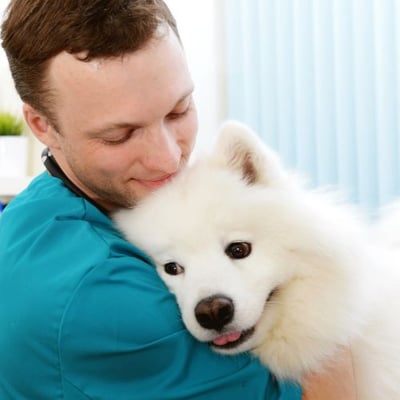 An experiment conducted by psychologists at Oberlin College in Ohio and Trinity University in San Antonio revealed that 20% of the people surveyed had an aversion or hatred to the word moist.
An experiment conducted by psychologists at Oberlin College in Ohio and Trinity University in San Antonio revealed that 20% of the people surveyed had an aversion or hatred to the word moist.
On many sites, this is listed as the most hated word, and some feel so strongly about it they feel it should be completely removed from the English language. I don’t think we need a study or an experiment to know that 100% of people hate hearing the word ‘cancer.’ When people hear the word ‘cancer,’ they are filled with intense negative emotions.
I hope, after learning more about cancers that affect dogs and the advances in screening, monitoring, and treatment, that that word no longer causes you to have the same intense level of negative feelings. Many types of cancers in dogs are treatable, especially when caught early.
Before we jump deeper into more details about cancer, I thought it might be helpful to provide you with some basic statistics and some general facts about dogs and cancer. If that isn’t your thing, feel free to jump ahead!
Skip to section:
Dog Cancer Statistics
- There are 89.7 million dogs in the United States, per the American Pet Products Association 2017–2018 National Pet Owners Survey (Insurance Information Institute).
- In the United States, about 6 million new cancer diagnoses are made in dogs each year.
- Per one study, cancer (8.7%) is one of the top causes of death in dogs, second only to old age at 13.8%. Some studies indicate it is by far the leading cause of death in adult dogs. `
- Approximately 1 in 4 dogs, per the Veterinary Cancer Society, will at some point develop cancer.
- For dogs over the age of 10, it is estimated that about 50% will develop cancer.
- If caught early, about half of all cancers are treatable in dogs.
- One of the most common cancers in dogs is lymphoma. It accounts for as many as 24% of all new cancer diagnoses. In generally healthy dogs, with early detection and treatment, about 80% to 90% achieve full remission.
- About 50% of all mammary tumors are malignant, with the mean age of development being between 6 and 10 years of age. The development of mammary cancer is dramatically decreased when dogs are spayed prior to their first heat. The risk of mammary cancer for dogs spayed before the first heat cycle is 0.5%. This number increases to 8% after the first heat cycle and 26% after the second.
- The most common type of bone cancer is osteosarcoma. About 85% of all skeletal tumors are osteosarcoma.
- Bone cancer risk is increased for large and giant breed dogs as young as 6 years of age.
- The five most common skin cancers in dogs:
- Mast Cell tumor – the most common type of skin cancer. It accounts for up to 20% of all skin cancers in dogs.
- Melanoma
- Squamous cell carcinoma
- Fibrosarcoma
- Cutaneous epitheliotropic lymphoma
- Some of the most common canine cancers:
- Lymphoma/Lymphosarcoma
- Hemangiosarcoma
- Bone cancer
- Oral cancer
- Soft tissue sarcomas
- Mast cell cancer
- Mammary gland carcinoma
- Lung cancer
- Bladder cancer
- Adrenal Cancer
- Liver cancer
- Malignant melanoma
- Anal sac adenocarcinoma
- Cancer risks in dogs are increased by second-hand smoke.
- Certain types of cancer development in animals have been linked to obesity.
- The dog breeds with the highest rates of cancer include:
-
- Beagle
- Bernese Mountain Dog
- Boxer
- German Shepherd
- Golden Retriever
- Labrador Retriever
- Poodle
- Rottweiler
- Scottish terrier
-
- Chihuahua
- Dachshund
- Miniature Pinscher
- Pomeranian
- Toy Poodle
- Yorkshire Terrier
18. According to Nationwide research, purebred dogs have 1.9 times greater chance of developing cancer than cross-bred or mixed-breed dogs.
Cancer Screening for Dogs
Screening for cancer is a routine part of care for us, especially when we reach a certain age. There are established guidelines to help detect cancer in its early stages. The earlier cancer is detected through screening, the better the outcome.
The same concept applies to cancer in dogs. Cancer develops over time. When it is detected in its earlier stages, your dog’s survivability is significantly increased. When detection is delayed until clinical signs have developed, the cancer is already in the later stages. This means it has grown and likely spread.
“With most cancers, the more cells you have to kill with chemotherapy or with radiation, or the larger the tumor, the more difficult it becomes, and the outcome is poorer,” said Dr. Kimberly Cronin, a board-certified veterinary radiologist working at a referral practice in Boston.
Cancer found in the early stages is less likely to have metastasized (spread to other areas of the body), dogs are generally in a healthier state, and the cancer is generally more treatable and possibly curable.
“Early detection is critical for successful treatment, recovery, and quality of life,” per the AKC Canine Health Foundation.
When to Start Screening and What to Have Done
The initiation of screening isn’t a ‘one size fits all’ type of thing. The diversity in dog sizes and the many breeds make it difficult to establish a steadfast approach. Therefore, I will give you some guidelines to help you determine when the best time is to start having your dog screened.
Annual and Bi-Annual Cancer Screening
The average age for dogs to develop cancer is 8.8 years of age.
However, there are certain breeds that have an average age of 6.0 to 6.2 years. Those breeds in this category include:
- Boxer
- Bulldog
- Great Dane
- Irish Wolfhound
- Mastiff
- Saint Bernard
Screening for cancer should begin 2 years prior to the average age of diagnosis – between 6 and 8 years old.
It is important to have your dog get annual routine exams from the time they are young to help prevent and detect many illnesses early, including cancer. Sadly, cancer isn’t just an older or senior dog issue. I have had dogs as young as 5 years old, including one of my own, have cancer.
Increase routine visits to twice a year when your dog reaches the age (based on their breed and cancer risk) when cancer development is more likely. For example, if you have a boxer, start having them checked twice a year around 4 years of age.
A complete physical examination, CBC (evaluates red and white blood cell counts, platelet numbers, etc.), blood chemistry (evaluates organ function, electrolyte balances, etc.), urinalysis, monitoring of any skin issues and lumps and bumps, and possibly x-rays are all part of establishing your dog’s baseline and aid in the screening process.Note: I always recommend having old and new lumps and bumps screened by your veterinarian using a fine needle aspirate or biopsy (these techniques take a small piece of tissue for evaluation). Existing benign lumps and bumps can develop into cancer over time. Therefore, continual monitoring is recommended.
Advancements in Cancer Screening and Diagnosis
Through research and studies, the understanding of cancer and how to detect and treat it has advanced significantly over the years.
Liquid Biopsy
One of the biggest advances, in my opinion, is the liquid biopsy. A liquid biopsy (Nu.Q Vet Cancer Test) is a simple blood test used for the early detection of multiple types of cancer by evaluating the level of nucleosomes in the blood. Nucleosomes are elevated in some cancers, especially the most common systemic cancers, such as lymphoma and hemangiosarcoma.
The wonderful thing is that you can non-invasively and simply screen your dog routinely for cancer before they have any symptoms with a simple blood draw (cost ranges from $50–200).
When the test indicates that there is a ‘risk level,’ it alerts your veterinarian to recommend further diagnostic testing, such as X-rays, ultrasound, CT scan, or an MRI, to help confirm the diagnosis. By having the cancer risk level prompting further confirmatory testing, a diagnosis is made sooner, and treatment can be initiated faster with potentially more options available.
In some cases, the diagnosis of certain cancers can be challenging, even when suspected. This is especially true in those instances where the area of cancer is a challenge to access, or it is not clinically evident. In these instances where cancer was suspected, the liquid biopsy can aid in the diagnosis since it reliably detects 76% of systemic cancers (cancers that affect the entire body).
 Currently, there are over 7 different types of cancer that the Nu.Q Vet Cancer Test can detect prior to noticing any symptoms, with additional being studied. Of the most common cancers affecting dogs, it has a high detection rate of about 76% (lymphoma, hemangiosarcoma, and histiocytic sarcoma). Even more assuring is that the test has a low false positive rate of 3%. This means that for every 200 dogs tested, only 6 incorrectly received a positive test result.
Currently, there are over 7 different types of cancer that the Nu.Q Vet Cancer Test can detect prior to noticing any symptoms, with additional being studied. Of the most common cancers affecting dogs, it has a high detection rate of about 76% (lymphoma, hemangiosarcoma, and histiocytic sarcoma). Even more assuring is that the test has a low false positive rate of 3%. This means that for every 200 dogs tested, only 6 incorrectly received a positive test result.
Note: Hemangiosarcoma is one of the most common cancers among many of the high-risk breeds. It originates in the bone marrow and tends to spread to the heart and spleen (these are the locations where it is often detected). It has a tendency to grow and spread rapidly as well as suddenly rupture and bleed.
Often, owners are not aware of what is going on until it is too late. At that point, even with surgery and chemotherapy, the average survival time is 5–7 months. About 10% of dogs survive for one year. BUT with the Nu.Q cancer test allowing for earlier detection, I believe these statistics will change since the diagnosis can possibly be made prior to seeing symptoms and potential rupture of the tumor.
A final benefit of the liquid biopsy is that it can be used as an ongoing monitoring tool to evaluate your dog’s response to cancer treatment or surgery as well as its reoccurrence.
Inflammation
Inflammation, especially if it is chronic, can cause harm to your dog’s body. It can have an impact on their gastrointestinal tract and joints and even advance and cultivate tumor growth. Managing your dog's weight and arthritis are some ways to help keep inflammation down.
This link between inflammation and cancer and the need to develop ways to detect cancer early led VDI Laboratory to develop the Cancer Risk Assessment (CRA). The CRA has not only the benefit of helping detect cancer earlier, but it also offers the benefit of detecting chronic inflammation since it is a leading cause of many other serious health issues, like... This a screening test meant to assess healthy dogs with no noticeable signs of cancer. It is in no way a diagnostic test.
The Cancer Risk Assessment is recommended for:
- Seemingly healthy dogs
- Dogs that are 5+ years of age
- Breeds that are at high risk of cancer
- Dogs that are genetically predisposed (history in their breed line) to cancer
Having your dog evaluated every four months provides the best outcome, but every six months is adequate. In the clinical study conducted out of the University of Missouri, 82% of the cancers were detected six months before clinical signs.
What to Do After a Cancer Diagnosis
Knowing your dog has cancer is devastating. Your mind is filled with thousands of questions and thoughts. Deciding what to do is a very personal decision. You know your dog and what is best for them.
I recommend consulting with a veterinary oncologist following your dog’s cancer diagnosis. They will be able to provide you with all the information you need about your dog’s particular cancer and what treatment options they may have. Read some tips from an oncologist on how to prepare.
Cancer treatment options will likely include one or more of the following:
- Surgery – Surgical removal of all or most of the cancer.
- Radiation – Cancer cells are killed or shrunk using high doses of concentrated X-rays
- Chemotherapy – Intravenous and/or oral drugs are used to treat cancer
Most dogs tolerate chemotherapy very well. The majority of dogs have no side effects. Mild side effects that last only a few days resolve on their own with no treatment, are only experienced by about 15% of dogs. Less than 10% of cases will have significant side effects.
- Intratumoral injection – This is a newer and more novel treatment option. A specific drug is injected directly into the tumor, and tumor cells disintegrate as a protein activated by the drug spreads through them. This offers hope for a less invasive form of treatment for cancer.
The drug is Stelfonta, an FDA-approved intratumoral injection for the treatment of non-metastatic cutaneous and subcutaneous mast cell tumors. - Immunotherapy – A newer concept in cancer treatment where cancer cells are destroyed using your dog’s own immune system. It is a targeted approach where cancer cells are destroyed, and healthy cells are left unharmed. It appears to be more beneficial following other treatments such as surgery, chemotherapy, or radiation since it does best with smaller ‘cancer loads.’
Clinical trials are being conducted to evaluate vaccines as an immunotherapy prevention for melanomas rather than a treatment for cancer. - Palliative care – Your dog is provided medications that manage their discomfort and any symptoms that may occur due to their cancer. Read more about managing your dog's palliative care.
- Holistic treatments – This includes many different modalities of treatment, from massage and acupuncture to specially formulated supplements, tinctures, and herbal mixtures. To explore these options, consult with a veterinary integrative oncology consultant.
Cancers by Breed
Before entering veterinary school, I had a list of about 20 dog breeds I wanted to own. It turned out that the majority of the ones on the list were at an increased risk for cancer. After what I learned about which breeds were affected by cancer in veterinary school and then my first experience of my personal dog, my heart dog, having cancer, I realized that I was not capable of dealing with that heartache. So I became a ‘mutt pup’ mom! But now, after all these many (many!) years have passed and the advances that have been made with regard to screening and treatment, I can likely re-create my list.
As I just mentioned, the advances in research with regard to canine cancer give us all hope. But, I always feel it is best to know, prior to getting a dog, what medical conditions they seem to be predisposed to, especially cancer. So that you can be prepared and take the necessary precautions and provide the appropriate yearly screening.
While there are other types of cancers that these breeds can be diagnosed with, these are some of the more commonly diagnosed cancers for these breeds that have an overall increased risk for cancer:
Beagles
- Squamous cell carcinoma
- Thyroid carcinoma
- Transitional cell carcinoma
Bernese Mountain Dogs
- Lymphoma
- Mast cell tumors
Boxers
- Hemangiosarcoma
- Lymphoma
- Mast cell tumors
- Thyroid carcinoma
German Shepherds
- Lymphoma
- Mast cell tumors
- Hemangiosarcoma
- Osteosarcoma
Golden Retrievers
- Hemangiosarcoma
- Lymphoma
- Mast cell tumors
- Melanoma
- Osteosarcoma
- Thyroid carcinoma
Labrador Retrievers
- Hemangiosarcoma
- Mast cell tumors
Poodles
- Lymphoma
- Mammary cancer
- Melanoma
Rottweilers
- Hemangiosarcoma
- Lymphophoma
- Mast cell tumors
- Osteosarcoma
- Soft tissue sarcomas
- Transitional cell carcinoma (bladder cancer)
Scottish Terriers
- Melanoma
- Lymphoma
- Transitional cell carcinoma
The Warning Signs of Cancer in Dogs
The symptoms of cancer are as vast as the different types of cancer that can be diagnosed. But if you notice any of these symptoms or warning signs, even if your dog isn’t in a high-risk group or near the average age of cancer, consult with your veterinarian.
- New or abnormal lumps
- Persistent swelling of an area, especially if it spreads or increases in size
- Bad breath
- Weight loss
- Change in appetite
- Difficulty urinating
- Difficulty pooping
- Difficulty breathing
- Difficulty eating
- Difficulty swallowing
- Wounds or sores that won’t heal
- Lameness
- Cough, especially if continual
- Bleeding
- Chronic vomiting and/or diarrhea
- Distended abdomen
- Enlarged or swollen lymph nodes (under the jaw, armpit, point of shoulder, groin, and behind the knee)
Help your dog stay well and live a long life by providing them with preventive care and having them get routine veterinary evaluations.
Early detection saves lives!





